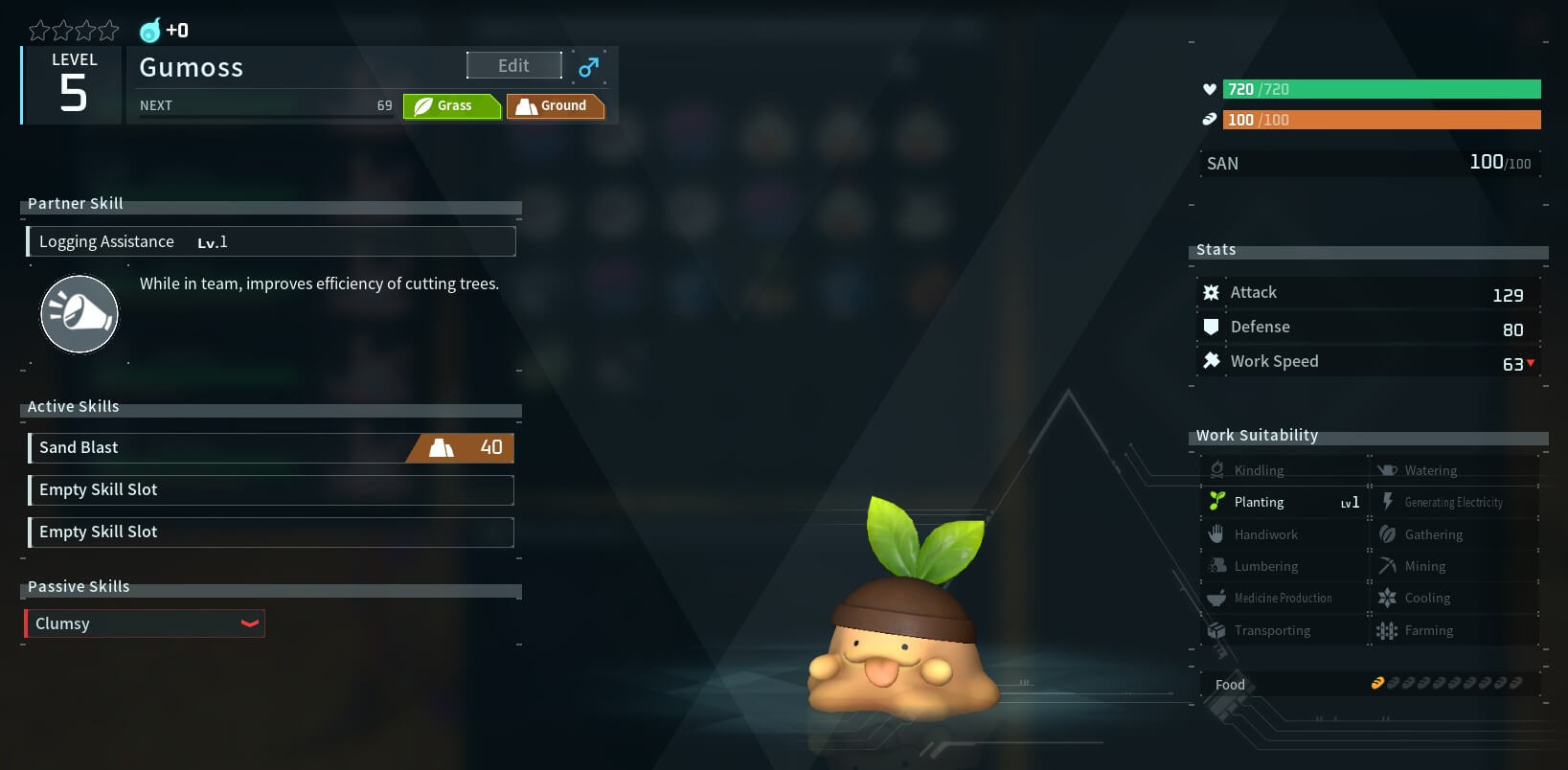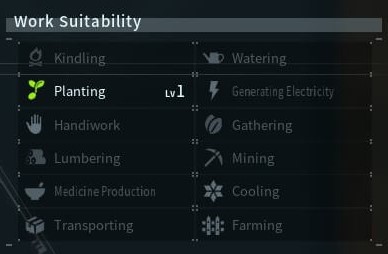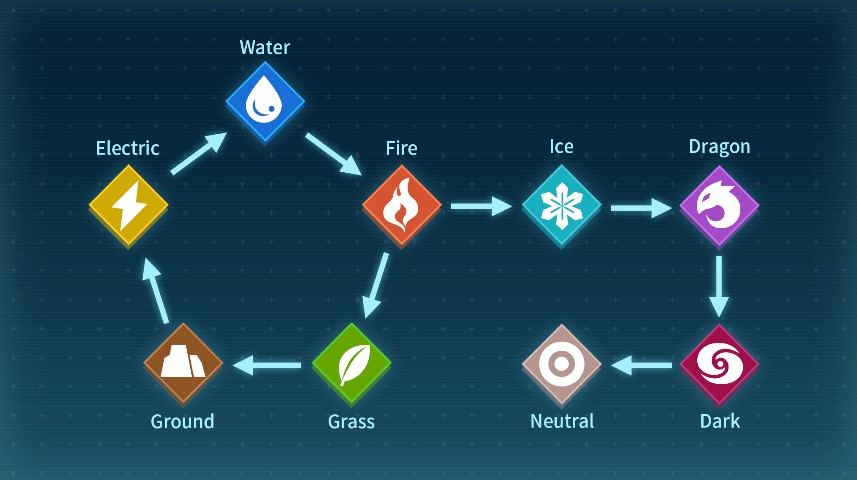Palworld Elements Guide: Strengths, Weaknesses, and Work Suitability
In this Palworld elements guide, we’ll cover what the elements are, how they have strengths and weaknesses against each other, and the work suitabilities they’re associated with.
If you’re coming from the Pokemon world, you’ll be very familiar with the elemental type system – however, there are a few differences in comparison to Palworld’s.
Let’s dive in!
What are Palworld Elements?
In Palworld, every pal has at least one elemental type (some have more!). This usually ties into their appearance, name, and abilities.
Let’s take a look at Gumoss, a useful early game pal as an example. To find a pal’s elements, just check your Paldeck.
Gumoss is one of the pals that has two elements, Grass and Ground. This means that it will naturally learn Active Skills (the abilities pals use in battle) as they level up.
Right now, it has Sand Blast (a ground attack) but will learn abilities like Wind Cutter (Grass) next.
In addition to Active Skills, you also have a pal’s Partner Skill. Partner Skills can be active abilities you can cast on a cooldown or can be passive bonus effects.
Gumoss’s Partner Skill is Logging Assistance, which helps you cut trees faster. Although this is sort of a funny relation to its elemental theme since it’s encouraging you to kill other plants…
Lastly, Gumoss’s Work Suitability is one level in Planting. We’ll cover Work Suitability and its relation to the elements in more detail in a later section.
Overall, the main takeaway is that the pal’s element ties into their theme and function, both in and out of combat.
The Elemental Chart (Strengths and Weaknesses)
Just like one of its obvious influences, Pokemon, Palworld includes an elemental rock-paper-scissors system.
Every type of element has interactions specific other elements. Here’s a look at the in-game chart from the Survival guide.
The arrows pointing toward an element mean that the element is stronger against that element. So for example, Water –> Fire means Water attacks deal more damage against Fire-type pals.
This also means that Fire Skills do less damage against Water-type pals.
Here’s a chart version if the arrows are weird to follow:
| Element | Strong Against | Weak Against |
|---|---|---|
| Dark |
Neutral |
Dragon |
| Dragon |
Dark |
Ice |
| Electric |
Water |
Ground |
| Fire |
Grass and Ice |
Water |
| Grass |
Ground |
Fire |
| Ground |
Electric |
Grass |
| Ice |
Dragon |
Fire |
| Neutral |
None |
Dark |
| Water |
Fire |
Electric |
Something to note is that Fire is strong against both Grass and Ice while Neutral is not strong against anything.
Differences from Pokemon’s Element Chart
If you’re a Pokemon player you’ll feel right at home with Palworld’s elemental system, but there are some differences to take note of:
- Grass doesn’t beat Water
- No Ghost, Psychic, Fairy, Bug, Poison, Fighting, Rock, or Poison.
- There aren’t any elemental interactions that cause 0 damage (like Normal vs Ghost, Electric vs Ground, or Ground vs Fly)
Elements and Work Suitability
Although Palworld is similar to Pokemon and other monster tamers in many ways, there are also aspects that make Palworld distinct.
One of those key differences is Work Suitability, which refers to how your pal contributes to your base if they are stationed there as a worker.
The twelve Work Suitability skills are:
- Kindling
- Watering
- Planting
- Generating Electricity
- Handiwork
- Gathering
- Lumbering
- Mining
- Medicine Production
- Cooling
- Transporting
- Farming
Although there are some exceptions, a pal’s element and general theme will usually indicate what sort of work they’ll be good at.
Here’s a breakdown of the crossover, note that we mean that there is at least one pal of the element that has the skill, they do not all the possible skills listed:
- Dark and Neutral
- These are paired together because pals of these elements tend to do a lot of things.
- Mining
- Transporting
- Farming
- Gathering
- Handiwork
- Kindling (only Dark, no Neutral)
- Lumbering
- Medicine
- These are paired together because pals of these elements tend to do a lot of things.
- Dragon
- Dragon is another very versatile type since it’s often in combination with another element.
- Mining
- Planting
- Transporting
- Watering
- Cooling
- Gathering
- Generating Electricity
- Handiwork
- Kindling
- Lumbering
- Dragon is another very versatile type since it’s often in combination with another element.
- Electric
- Transporting
- Gathering
- Handiwork
- Lumbering
- Fire
- Mining
- Transporting
- Farming
- Gathering
- Handiwork
- Kindling
- Lumbering
- Grass
- Mining
- Planting
- Transporting
- Watering
- Farming
- Gathering
- Handiwork
- Lumbering
- Medicine Production
- Ground
- Mining
- Planting
- Transporting
- Watering
- Cooling
- Gathering
- Handiwork
- Kindling
- Lumbering
- Medicine Production
- Ice
- Mining
- Transporting
- Watering
- Cooling
- Farming
- Gathering
- Handiwork
- Lumbering
- Medicine Production
- Water
- Mining
- Transporting
- Watering
- Cooling
- Handiwork
- Lumbering
 Download APP
Download APP



